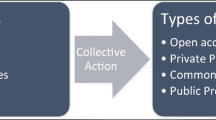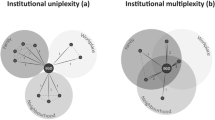Abstract
Collective action processes in complex, multiple-use common-pool resources (CPRs) have only recently become a focus of study. When CPRs evolve into more complex systems, resource use by separate user groups becomes increasingly interdependent. This implies, amongst others, that the institutional framework governing resource use has to be re-negotiated to avoid adverse impacts associated with the increased access of any new stakeholders, such as overexploitation, alienation of traditional users, and inter-user conflicts. The establishment of “platforms for resource use negotiation” is a way of dealing with complex natural resource management problems. Platforms arise when stakeholders perceive the same resource management problem, realize their interdependence in solving it, and come together to agree on action strategies for solving the problem (Röling, 1994). This article sets the scene for a discussion in this Special Issue about the potential of nested platforms for resource use negotiation in facilitating collective action in the management of complex, multiple-use CPRs. The article has five objectives. First, we define “collective action” in the context of this paper. Second, we discuss the importance of collective action in multiple-use CPRs. Third, we introduce the concept of platforms to coordinate collective action by multiple users. Fourth, we address some issues that emerge from evidence in the field regarding the role and potential of nested platforms for managing complex CPRs. Finally, we raise five discussion statements. These will form the basis for the collection of articles in this special issue.
Similar content being viewed by others
References
Barrett, G. (1991). “The fish pot ban: Reef overfishing and state management in Bermuda,” Maritime Anthropological Studies 4: 17–39.
Bromley, D.W., D. Feeny, M. A. McKean, P. Peters, J. L. Gilles, R. J. Oakerson, C. F. Runge, and J. T. Thomson (1992). Making the Commons Work: Theory, Practice and Policy. San Francisco: ICS Press.
Campbell, A. (1994). Landcare: Communities Shaping the Land and the Future. St. Leonards, NSW: Allen and Unwin.
Checkland, P. B. (1981). Systems Thinking, Systems Practice. Chichester: John Wiley.
Checkland, P. B. (1989). “Soft systems methodology,” Human Systems Management 8: 273–289.
Cutler, C., R. Costanza, T. Eggertsson, L. Fortman, B. Low, M. McKean, E. Ostrom, J. Wilson, and O. Young (1995). “The relationship between ecosystems and human systems: Scale challenges in linking property rights systems and natural resource management.” Paper presented at the 5th Conference of the International Association for the Study of Common Property. Bodø, Norway, 24–28 May 1995.
Daniels, S. E. and G. B. Walker (1996). “Collaborative learning: Improving public deliberation in ecosystem-based management,” Environmental Impact Assessment Review 16: 71–102.
Edwards, V. M. (1996). Managing the Commons: A Framework for the Analysis of Institutional Change and its Application to the Management of the Multiple Use Commons of the New Forest. Research Monograph. Portsmouth, UK, University of Portsmouth.
Edwards, V. M. and N. A. Steins (1998a). “Developing an analytical framework for multiple-use commons,” Journal of Theoretical Politics 10(3): 347–383.
Edwards, V. M. and N. A. Steins (1998b). “Contextual factors in common-pool resource management.” Paper presented at the 7th Conference of the International Association for the Study of Common Property. Vancouver, Canada, 10–14 June 1998.
Edwards, V. M. and N. A. Steins (forthcoming). Complex Commons: An Analysis of the Management of Natural Resources with Multiple Users and Multiple Rights. Cambridge: Cambridge University Press (under contract).
Engel, P. G. H. and M. Salomon (1997). Facilitating Innovation for Development: A RAAKS Resource Box. Amsterdam: KIT.
Feeny, D., F. Berkes, B. J. McCay, and J. M. Acheson (1990). “The tragedy of the commons: Twenty-two years later,” Human Ecology 18: 1–19.
Glasbergen, P. (1996). “Learning to manage the environment,” in W. M. Lafferty and J. Meadowcroft (eds.), Democracy and the Environment: Problems and Prospects (pp. 175–193). Cheltenham: Edward Elgar.
Hardin, G. (1968). “The tragedy of the commons,” Science 162: 1243–1248.
Keohane, R. O. and E. Ostrom (1995). Local Commons and Global Interdependence: Heterogeneity and Co-operation in Two Domains. London: Sage Publications Ltd.
Maarleveld, M., N. Röling, S. Seegers, and C. van Woerkum (1996). Social Learning for Collective Resource Management: Facilitation, Institutions and Policies. Wageningen, The Netherlands: Wageningen Agricultural University, Department of Communication and Innovation Studies.
McCay, B. J. and J. M. Acheson (1990). The Question of the Commons: The Culture and Ecology of Communal Resources. Tuscon: University of Arizona Press.
Meinzen-Dick, R. and L. A. Jackson (1996). “Multiple uses, multiple users of water resources.” Paper presented at the 6th Conference of the International Association for the Study of Common Property. Berkeley, California, 6–10 June, 1996.
Olomola, A. S. (1992). “The traditional approach towards sustainable management in common property fishery resources in Nigeria,” Maritime Anthropological Studies 6(1/2): 207–224.
Olson, M. (1982). “The logic,” chapter 2 in The Rise and Decline of Nations: Economic Growth, Stagflation and Social Rigidities (pp. 17–35). London: Yale University Press.
Ostrom, E. (1990). Governing the Commons: The Evolution of Institutions for Collective Action. Cambridge: Cambridge University Press.
Ostrom, E. (1995). “Constituting social capital and collective action,” in R. O. Keohane and E. Ostrom (eds.), Local Commons and Global Interdependence: Heterogeneity and Co-operation in Two Domains (pp. 125–160). London: Sage Publications Ltd.
Parson, E. A. and W. C. Clark (1995). “Sustainable development as social learning: Theoretical perspectives and practical challenges for the design of a research program,” in L. H. Gunderson, C. S. Holling, and S. S. Light (eds.), Barriers and Bridges to the Renewal of Ecosystems and Their Institutions (pp. 428–486). New York: Columbia University Press.
Pinkerton, E. W. and M. Weinstein (1995). Fisheries that Work: Sustainability through Community-Based Management. Vancouver: The David Suzuki Foundation.
Röling, N. G. (1992). “The emergence of knowledge systems thinking,” Knowledge and Policy: The International Journal of Knowledge Transfer and Utilization 5(1): 42–64.
Röling, N. G. (1994). “Communication support for sustainable natural resource management,” IDS Bulletin 25: 125–133.
Röling, N. G. (1997). “The soft side of the land: Socioeconomic sustainability of land use systems.” Invited paper for the conference “Geo-Information for Sustainable Land Management,” organized by the ITC. Enschede, The Netherlands, 17–21 August 1997.
Röling, N. G. and J. Jiggins (1998). “The ecological knowledge system,” in N. G. Röling and M. A. E. Wagemakers (eds.), Facilitating Sustainable Agriculture: Participatory Learning and Adaptive Management in Times of Environmental Uncertainty (Chapter 16). Cambridge: Cambridge University Press.
Röling, N. G. and M. A. E. Wagemakers (1998). Facilitating Sustainable Agriculture: Participatory Learning and Adaptive Management in Times of Environmental Uncertainty. Cambridge: Cambridge University Press.
Schlager, E. (1995). “Policy making and collective action: Defining coalitions within the advocacy coalition framework,” Policy Sciences 28: 243–270.
Scott, A. (1996). “The role of coastal forums in coastal zone management: Case study of Cardigan Bay Forum,” in J. Taussik and J. Mitchell (eds.), Partnership in Coastal Zone Management (pp. 557–564). Cardigan: Samara Publishing Ltd.
Selsky, J. W. and S. Creahan (1996). “The exploitation of common property natural resources: A social ecology perspective,” Industrial and Environmental Crisis Quarterly 9: 346–375.
Singh, K. (1994). Managing Common-pool Resources: Principles and Case Studies: Delhi: Oxford University Press.
Steins, N. A. (1997a). Balancing Fisheries and Nature: Three Case Studies of Fisheries Co-management in the Dutch Wadden Sea. Centre for Coastal Zone Management, University of Portsmouth, UK: Working Papers in Coastal Zone Management No. 24.
Steins, N. A. (1997b). From Single Use to Multiple-use: Cooperation and Conflict in Marine Resource Management in NW Connemara, Ireland. Centre for Coastal Zone Management, University of Portsmouth, UK: Working Papers in Coastal Zone Management No. 22.
Steins, N. A. (1998). “'We have to keep the foreigners out of our bay': Top-down regulations and the strategic response of Irish fishermen,” in D. Symes (ed.), Property Rights and Regulatory Systems for Fisheries (pp. 174–187). Oxford: Fishing News Books.
Steins, N. A. (in prep.). Doctoral dissertation. Department of Communication and Innovation Studies, Wageningen Agricultural University, The Netherlands.
Steins, N. A. and V. M. Edwards (1998). “Harbor resource management in Cowes: An analytical framework for multiple-use decision-making,” Journal of Environmental Management 54(1): 67–83.
Swallow, B. and D. W. Bromley (1995). “Institutions, governance and incentives in common property regimes for African rangelands,” Environmental and Resource Economics 6: 99–118.
Symes, D. (1996). “Co-governance in marine and coastal fisheries,” Proceedings of the Seminar on Co-Management “Cooperation in Management to the North Sea and Wadden Sea.” The Hague: Ministry of Agriculture, Nature Conservation and Fisheries, Fisheries Directorate.
Wade, R. (1988). Village Republics: Economic Conditions for Collective Action in South India. Cambridge: Cambridge University Press.
White, T. A. and C. F. Runge (1995). “Co-operative watershed management in Haiti: Common property and collective action,” Unasylva 180(46): 50–57.
Young, O. R. (1995). “The problem of scale in human/environment relationships,” in R. O. Keohane and E. Ostrom (eds.), Local Commons and Global Interdependence: Heterogeneity and Co-operation in Two Domains (pp. 27–46). London: Sage Publications Ltd.
Author information
Authors and Affiliations
Rights and permissions
About this article
Cite this article
Steins, N.A., Edwards, V.M. Platforms for collective action in multiple-use common-pool resources. Agriculture and Human Values 16, 241–255 (1999). https://doi.org/10.1023/A:1007591401621
Issue Date:
DOI: https://doi.org/10.1023/A:1007591401621




